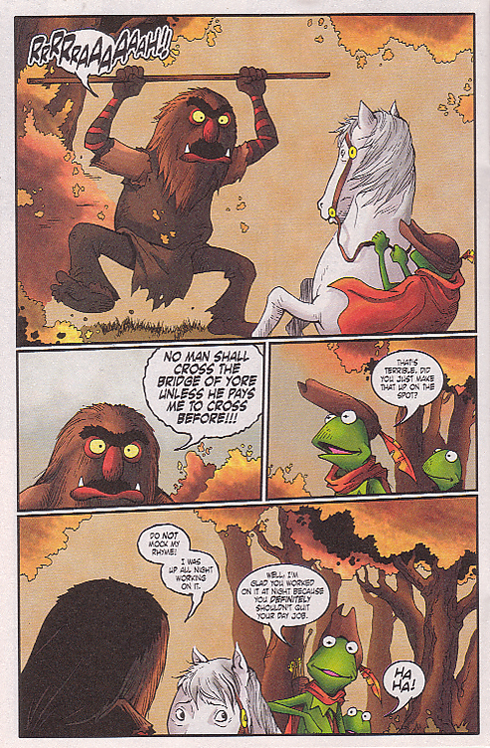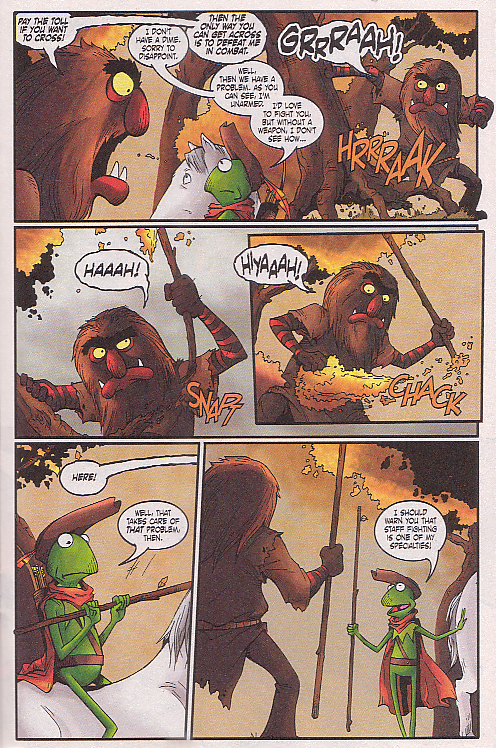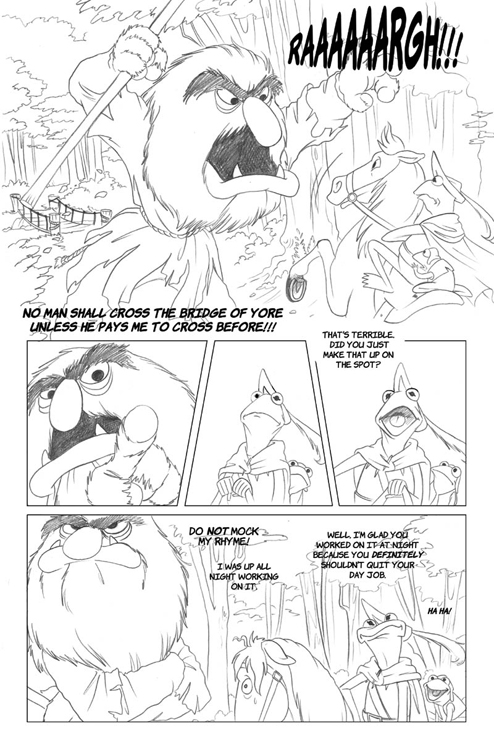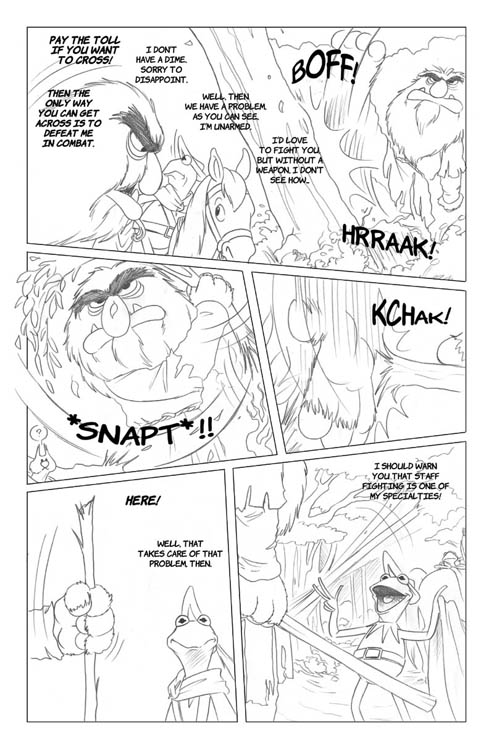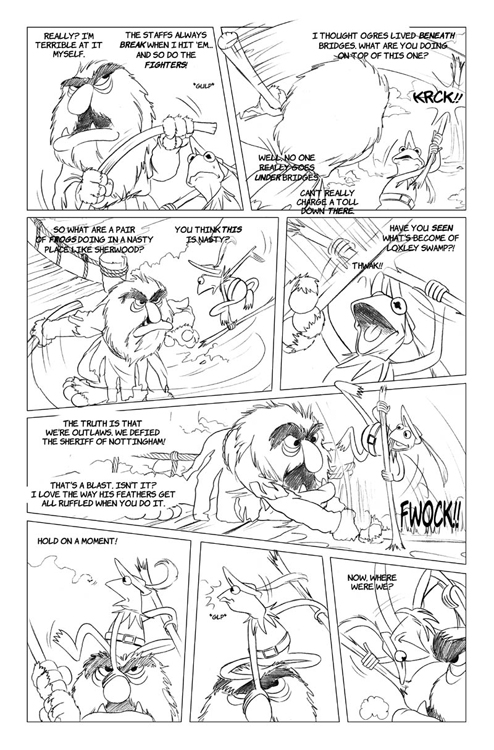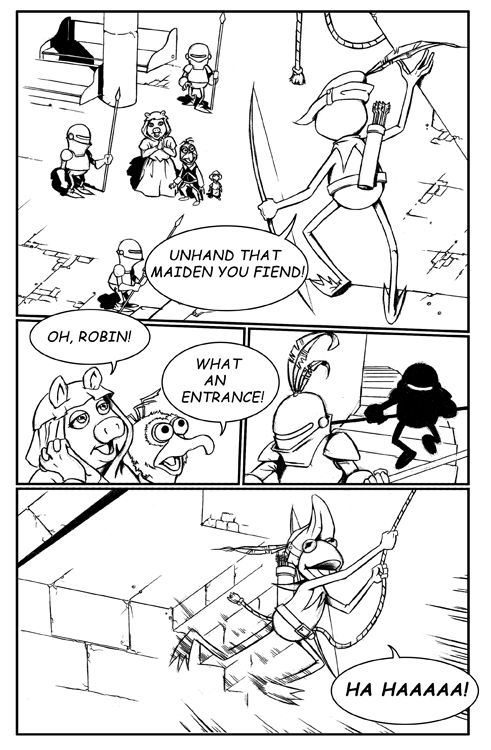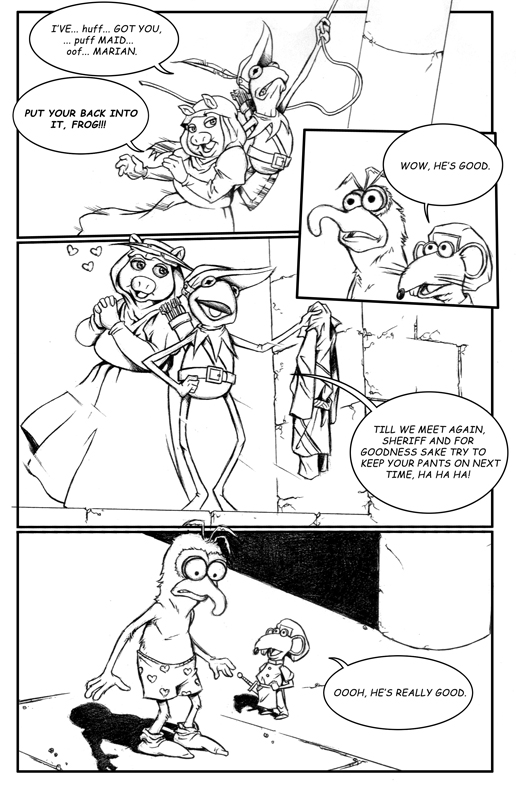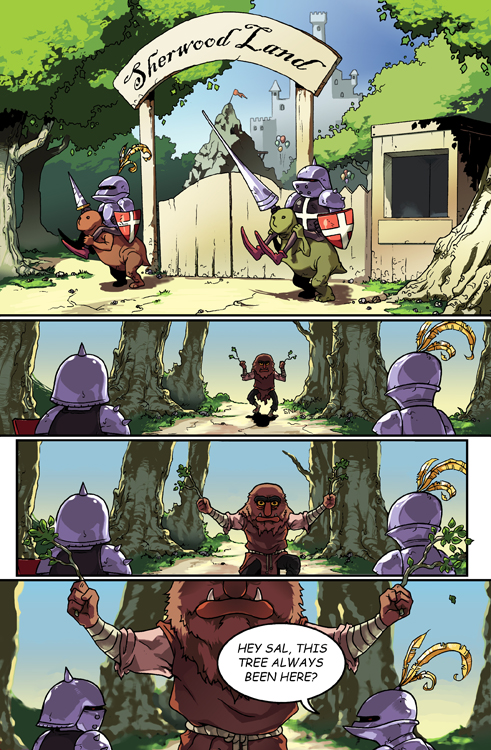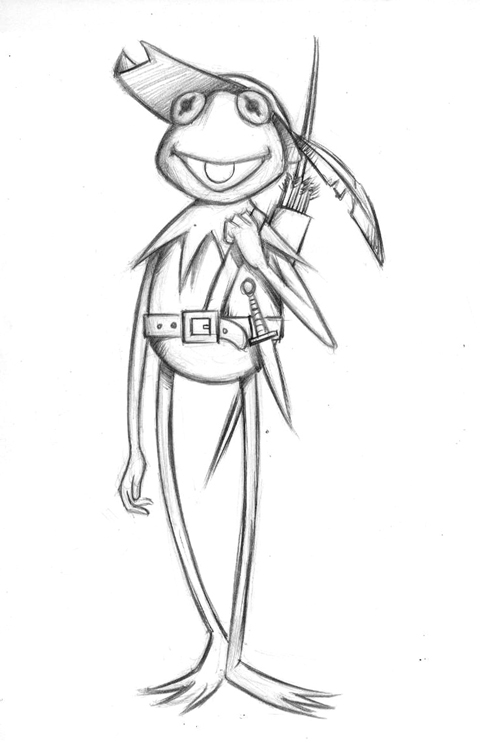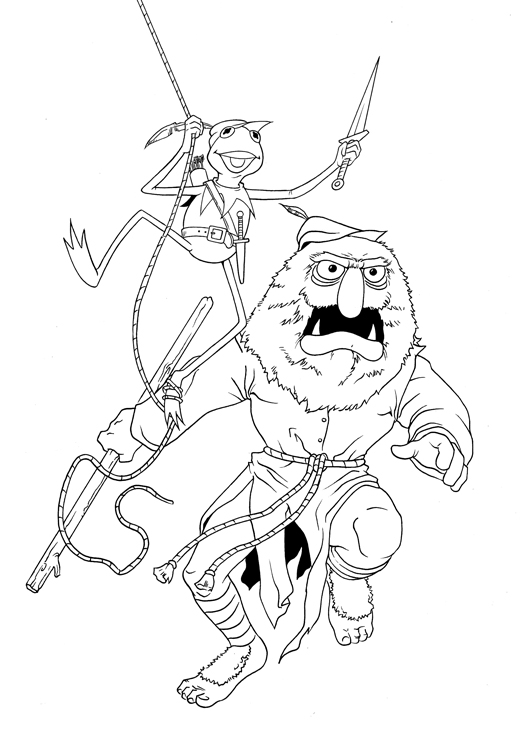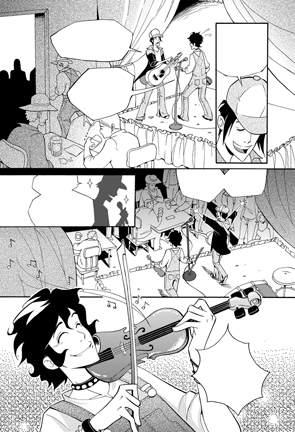There have been a few Fraggle Rock writers and artists who have contributed more than one story to the series, but so far, there’s only been one creator who has written one story and drawn another: Nichol Ashworth.

That might not be a name that you recognize right now, but give it a few years. Nichol first came to my attention near the end of my stint at Tokyopop, largely due to the creativity she displayed in the entries she submitted to Tokyopop’s Rising Stars of Manga contest. Traditionally, most of the entries we received fell into a few uninspired categories—epic fantasies that drew heavy inspiration from RPGs, shoujo romances set in private high schools or violent actioners that channeled Lone Wolf and Cub. The truly unique entries always stood out, and Nichol’s were utterly unique.
When thinking of artists who might be good for Fraggle Rock, Nichol was one of the first people who came to mind. For starters, I knew she was a huge Jim Henson fan, but more than that, she possessed the same sort of vivid, unpredictable, humanistic, yet slightly warped imagination that Jim had. The only problem was that I didn’t need artists. I needed writers. Fortunately, Nichol is every bit as gifted with words as she is with lines, and she knew these characters remarkably well. Her Fraggle Rock story, “Boober the Doozer,” was included in Archaia’s Free Comic Book Day issue last year, making it one of the most widely distributed Fraggle Rock comics in print.
However, as a big fan of her art, I really wanted to see Nichol draw the Fraggles as well as write them, especially after spending this year’s convention season watching her draw Fraggle sketches for anyone who came to her signings. With Vol. 2, I got my chance, pairing her up with Paul Morrissey for the funny, frantic short, “Red’s Chomp-a-Thon.”
We’ve had artists draw their own stories on Fraggle Rock, but Nichol was the only one to write and draw two separate stories for two separate creators. It may seem strange, but considering how much fun this girl is to work with, I’d do it again in a heartbeat.
Nichol, you first got on our radar at Tokyopop when you entered the company’s Rising Stars of Manga contest. I remember that your first entry was called “Muse,” and it was…well, there’s no getting around it, pretty dark and perverse. Did you deliberately set out to submit such a disturbing entry?
It’s funny, I really had no rhyme or reason for choosing that story over others. I think that “Muse” was just the most compelling idea I had at that moment. It’s based off of a nightmare I had, actually. On the one hand, yes, it’s very dark… and perhaps a bit perverse, but on the other hand, it definitely got attention! 🙂
Readers also really responded to “Muse.” Fans of manga-ka like Kaori Yuki and Fuyumi Soryo, especially. I kept it up on my Tokyopop artist’s page for a long time and got a lot of emotional responses to this piece. The story isn’t one that you can feel iffy on—it either creeps you out and you love it or you’re really upset about it and think that I’m demented.
Care to describe it for the people out there who are unfamiliar with it?
“When I was a baby, I was very sick. My mother, raising me alone, went almost mad at the sound of my cries. Her only way to cope was to draw my screaming faces over and over again. By the time I learned to smile, I didn’t have to any more… because I am her Muse.”
We can leave it there and let people yearn for the rest.
You didn’t win the contest your first time entering it, but “Muse” made quite an impression on the judges. I remember when we met you in person at Otakon the following year, we were surprised that such a dark entry came from such a sweet girl. Did you expect us to remember it? And when we did, were you thrilled that we didn’t freak out and call the cops?
Haha! Man, cops would have made for a smash entry into the world of comics, for sure! To be honest, since it did make it into the Top 20, I thought that SOMEONE must have read it… but the fact that the two editors I was doing a portfolio review with had read it—and remembered it—that was one of the coolest moments of my life. Especially since “Muse” was only the second comic I ever made!
The fact that you remembered my story is probably why I haven’t given up on my dreams to be a comic book writer and illustrator. I had a lot of trouble in college and none of my teachers believed in me and my “japanime” style. It was before anime and manga really hit pop culture, and they had a lot of prejudice about what that style meant and where it could take you. They thought that I was riding on a fad, not seeing enough of the genre to see where I was adding the “me.” I mean, let’s face it, all comic book characters have a general look to them. You’ve got your tall hero, fat, stumpy bad guy, etc, etc, etc. That’s true for Marvel as well as manga. The professors that I had just refused to see it in that light at the time. Since I love proving people wrong, I send a general middle-finger in the direction of all those artistically stunting people! With love, of course. I send it with love because their general distaste for me made me work harder—want it more.
Your next entry was one of our winners for that year, and what was so great about it was that it was so different from “Muse.” It was called “Chronicles of the Big Feet,” and it was about a family of bigfoots, err…big feet. What on earth inspired you to enter a manga contest with a short comic about monkey people?
Well, in my portfolio review, you guys said I needed more work on my backgrounds. Truth be told, I f-ing hate drawing buildings, so I wanted something outside. That same day, I sat down at my artist’s alley table and drew some monkey-men while I thought about what to do… thus “Chronicles” was born! It’s what I call “same-day-action.” I even still have the first draft (in colored marker) of the character designs I did that day.

A spread from "Chronicles of the Big Feet." Nichol can draw monkey people like no one's business.
I remember that I was a champion of it simply because it was so weird and different than what we usually saw in the contest. It was humorous, but it was clear that you hadn’t lost your edge. In fact, I believe you’re down on record as the only Rising Stars of Manga winner to feature pot prominently in your entry. Do you think Big Feet blaze up all that much?
Woot! Record! Point goes to me!
Funny thing is that I’m totally not a pot advocate or anything…and no, Big Feet are too smart for that! Above the influence and all that. BUT…they do know how to lure in humans!
Funny note about “Chronicles” (the fourth comic I ever drew) is that it has a very special cameo. The third comic I did, “Ledge,” was another very dark story. It had a main character that made a cameo in “Chronicles,” he then showed up in my next story, “Coprolalia,” about a girl with Tourette’s syndrome who wants to fall in love, and became the main character for another work in progress, Cog.
So did drawing a comic that featured a cast of hairy, non-human characters help prepare you at all for drawing Fraggle Rock? And what do you think would happen if the Fraggles ever got together with the Big Feet?
Absolutely! They’re all just big circles piled on top of each other with hair! Fantastic!
If the Fraggles met the Big Feet… Hmmmm… If we give the Big Feet the Uncle Travelling Matt feel then it would be like Gorg-sized monkeys doing documentaries on Fraggle life! (Ooooooh, fanfic!)

The opening page of "Boober the Doozer," one of the most widely distributed Fraggle comics we've published. Art is by Jake Myler with writing by Nichol.
How big of a Jim Henson fan are you? And how did it feel getting a chance to play in his playground with Fraggle Rock?
If I could kiss Jim, I would. Even now, which may be scary.
To say that he shaped my childhood is not an understatement. Between Fraggle Rock, Sesame Street and The Muppet Show; spin-offs like Muppet Babies; full length movies like Labyrinth and The Dark Crystal; and even the holiday specials like Emmet Otter’s Jug Band Christmas—I became a Henson devotee. I’d say that his shows helped me develop my love for fantasy, anthropomorphism and my general lack of fear when adding a touch of darkness to the light.
You’ve contributed twice to our Fraggle Rock series, once as a writer and once as an artist. Did you find one role more fulfilling than the other?
I was excited for both aspects and they were both really cool in different ways. It was my first time collaborating with others, so I’m glad that the experience and the outcome were both very positive. I’m going to lean towards saying that I loved the artwork more than the writing, but that’s only because I had almost-final control of the end product. As the writer, I wrote, then waved goodbye…and waited. As the artist, Paul Morrissey (the writer for “Red’s Chomp-a-Thon”) and I were able to team up and back-and-forth a bit to make something really special…and I touched it last! (Except for the letterer…whom I am very thankful for. The only repeated negative feedback I’ve ever gotten on my own work was on the font in my damn word bubbles. I hate stupid word bubbles… *mumblegrumble*)

A page from "Red's Chomp-a-Thon." In a reversal from her first Fraggle Rock story, Nichol drew this short, but didn't write it.
The story you wrote for us, “Boober the Doozer,” was actually one of the first ones we ran, and as a part of Archaia’s Free Comic Book Day offering last year, remains one of the most widely read Fraggle Rock comics we’ve published. Was it at all intimidating working on it? You had to know that lots of people would be seeing it.
Does it sound bad to say that the reality of it only came to me after it was already written? I was just so excited, jumping around singing “I’m going to write a Fraggle story, lalalaaa!” My main focus was to write something that would make both Jim Henson and the Fraggle fans happy to read. I thought, “If I can do that, then all the other pieces will just fall into place.”
It really wasn’t until the story was with the artist, Jake Myler, that I started to think, “Oh, does that mean I’m helping them put their best foot forward?!?” and “This is going to have the widest circulation of all the subsequent comics!” and “Eek, WTF have I done?!?!” “Will I be tarred and feathered?!?”
Thankfully, I was neither tarred, nor feathered. Instead, I got to do written interviews with MTV (and not for a reality TV show!) and USA Today. I’ll never forget the USA Today article…because it was Free Comic Book Day and it had a lot of authors and illustrators being interviewed. One of the comic splash pages shown was Superman. I thought to myself, “Damn… I’m in a USA Today article together with Superman. Someone kill me now, because it’s all downhill from here!
For your second contribution, “Red’s Chomp-a-Thon,” you had to draw the Fraggles stuffing their faces. Did you get hungry when you were drawing it? And what do you think Doozer sticks taste like?
Ohm nom nom nom (Cookie Monster reference, anyone?)
Oooh, there’s this one episode where they add mustard and tomato flavors to the Doozer sticks to make them more tasty for the Fraggles! I actually kept that thought in my mind when I painted the colors for the special Doozer constructions, thinking of tomato, blueberry and all these other fun things that could be mixed up into radish dust! (Does this make me [more of] a geek?)

An early page from Cog. The story began on a plantation in the slave era before moving forward in time.
Okay, on to more serious matters. You’ve been working on a project called Cog for the past few years, which actually began as a Tokyopop Pilot. Do you want to tell readers what it’s about?
Cog is a magnificent journey for me and it’s the most sophisticated plotline that I’ve conjured to date. Cog is a story about a lot of things: Love and Hate, Fate vs. Free Will, Human vs. Divine. It also challenges the Christian thought that the divine = good. It’s a story that has a lot of me in it. Some of the vignettes are purely my back story, retold in third person. Right now, one could say it’s my magnum opus, but I won’t because I’m too young for that crap. 😀
Cog’s premise is that the world’s fate is predetermined and must follow along a specific path. Some humans are essential to making the world’s time-clock flow forward. Cogs are created to find these humans that matter and make sure they fulfill the world’s destiny. Our story is about one Cog, the system that created him, the future he makes—and the future he does not.
One of my favorite parts of the story is my representation of the divine entity that controls the Cogs. I call them the Tinkers. They have no form of their own. When they manifest, they pause time and rip apart the fabric of reality to create these grotesque monstrosities—piecemeal of human parts, sidewalk, trees, wires—anything that was nearby when they appear. I think it’s super cool!
You and I actually worked together on Cog, and the project changed considerably as we were working on it. Are you happy with where it’s at now? And do you welcome that sort of involvement with an editor, or do you prefer when editors stay more hands off?
Cog began as a collection of short stories called Monsters, but you, Tim, said it needed a bow to tie it all together. It then became Cog as you and I know it today. I am forever grateful for that.
Since I’m pretty self-depreciative on a daily basis, having feedback from someone knowledgeable is key for me. I think that an editor is a partner, one who takes your jewel, polishes it and sets it in gold so that people will buy it. Or he tells you it’s a piece of crap that no one will ever buy and you move on… Still, I believe there are limits to an editor’s role. I mean, I think you’ll agree that while you’ve told me in the past that “this needs this,” you don’t write it for me. I still have the burden and joy of the creative solution!
I also have the right to disagree *mwahaha* and push my agenda.

A young girl dramatically confronts her dying father in Cog.
The Tokyopop Pilot program, along with Tokyopop itself, is no more, but at the time, it was a fairly controversial program. Frankly, I thought the criticism was all pretty overblown and even a little unfair myself, but what was your opinion about it?
Hmm… Well, as a new artist seeking more exposure, doing it and getting paid for it was great. The only thing that I thought was mildly unfair was that my pilot was over 40 pages and I got the same moolah as someone who did a 20-pager…but the longer story was also my personal choice, so I can only complain so much.
So what are your plans for Cog now?
Right now it’s being reviewed by a certain publishing house in the hopes that they’ll pick it up. But if they decide to pass, I’m moving on to the next publishing house to see what they say. I’ll never forget that Stephen King was turned down by over 100 publishers before someone picked up his first novel. And since I loves me some Stephen King, I’ll follow that example of tenacity.

Cog is told through a series of interrelated chapters, each one a complete story on it's own. This one is called "The Boy Who Draws Tigers" and introduces Daniel, a key character in the story.
Cog, like “Muse,” deals with some heavy themes and gets pretty dark at times. The chapter you wrote and drew as a pilot was set among slaves at a pre-Civil War Southern plantation. You seem drawn to dark stories, and yet you’re one of the funniest people I know. You have a great sense of humor and your art style lends itself well to funny stuff. Are we ever going to see a comedy from you?
Split personalities must lend themselves to a variety in style. *wink*
Funny stuff, though? Abso-tively-posi-lutely! Think of me like a boxer. No, not the dog. The greasy, sweaty man throwing jabs at yet another sweaty man. If I kept coming at you with right hooks, you’d know what to expect. I like to keep ya’ on yer toes. (Float like a buttahfly, sting like a bee!) You never know what you’ll see from me next, but hopefully you’ll know that it will be good!
I have artists that I trust. If I see a new series from them, I’m not going to buy just book one…I’m going to buy whatever is available/I can afford! Because, I just know I’m in for a good ride. I aspire to be an artist that’s consistent like that. Trusted by readers. Taking them for a good ride.
How would you define your art style? Are there any artists you’re particularly influenced by?
As a writer, I’m definitely influenced by ze King, as I mention above, but as an artist…it seems like a harder question. My style has changed over the years and will continue to change as I learn and grow, but I’ll say that my manga-style stuff nods to Kaori Yuki and Yayoi Ogawa.
I’ve read books that have emotionally moved me, and as a writer/illustrator, I really work to do that. To emotionally move someone that I have never met with my just my work. (No matter what direction I’m moving them in!)
And finally, you’re responsible for some of the best “unsanctioned” Fraggle Rock material we’ve received, including a couple of sketches of Mokey and Gobo making out that had us giggling at Comic-Con last summer. Do you think Mokey and Gobo really have a thing going? Don’t you think Gobo’s more into Red?
Red?! Pfft. No way, dude! Gobo totally has it for Mokey—but Mokey is oblivious and just loves everyone in that “artsy” way. Red, however, is gonzo over Gobo and totally jealous when he pays more attention to anyone other than her! And since the Fraggles act like kids, she reacts in a very kid-like way—she bothers him, picks on him and challenges his authority all the time.
On another note, I think that Wembley and Boober should be gay together. They’re not…but it is truly unfortunate… Fanfic opportunity #2!
For more information on Nichol’s work and upcoming projects, visit her website: www.nixcomix.com.
Or if you’re on Facebook, be sure to “like” her fan page: http://www.facebook.com/pages/Boston/NixComix/291714942383
That’ll do it for our series of Fraggle Rock creator interviews. But keep checking back for more information on Fraggle Rock, Dark Crystal and the other projects I’m working on, as well as thoughts, commentary and random groupings of characters created when I pass out on top of my keyboard.

